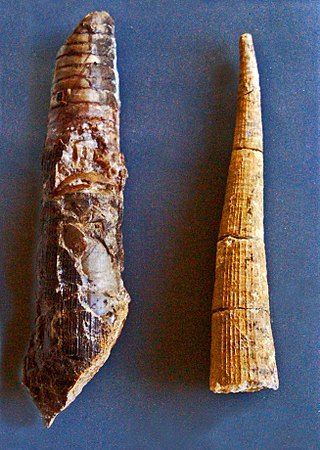Related Research Articles
Jangziceras is a genus of fossil nautiloid cephalopods from the Middle Silurian of southern China belonging to the Orthocerida incertae sedis, its familial association undetermined. The type is Jangziceras sichuanense Lai Chai-Geen. Its description falls within the characters of the Orthocerida.

Kionoceras is an extinct nautiloid cephalopod genus included in the orthocerid family Kionoceratidae with scattered worldwide distribution from the Middle Ordovician to the Lower Permian. Kionoceratids are orthocerids with prominent longitudinal ornamentation on their shells, sometimes augmented by secondary transverse ornamentation. Orthocerids are, of course, prehistoric nautiloides with generally straight and elongate shells, mostly with central or subcentral siphuncles.
Thoracoceras is an extinct genus of orthocerids from the family Kionoceratidae characterized by orthoconic shells marked by prominent longitudinal rounded grooves separated by angular ridges, each which has a single row of blunt spines along its apex, and having a small submarginal siphuncle.

Sinoceras is an extinct genus of nautiloids from China included in the family Orthoceratidae that lived from the middle Ordovician until the Devonian. The type species, S. chinense, was originally described as "Orthoceras chinense," but then was promoted by Shimizu and Obata to its own genus, Sinoceras, in 1935.
Bogoslovskya is an extinct orthoceroid cephalopod genus that lived in what is now Asia from the Devonian to the Permian.
Cryptocycloceras is an extinct genus of actively mobile carnivorous cephalopod that lived in what would be Europe during the Silurian from 422.9—418.7 mya, existing for approximately 4.2 million years.
Donacoceras is an extinct genus of actively mobile carnivorous cephalopod, essentially a Nautiloid that lived in what would be North America during the Ordovician from 460.5—443.7 mya, existing for approximately 16.8 million years.
Garryoceras is an extinct genus, probably from the actively mobile carnivorous cephalopod order Orthocerida, that lived in what would be North America during the Late Ordovician, from 460.5—443.7 mya, existing for approximately 16.8 million years.
Geisonocerina is an extinct genus from the carnivorous nautiloid cephalopod order Orthocerida that lived in what would be North America, Europe, and Asia during the Ordovician through Permian from 449 to 290 mya, existing for approximately 159 million years.
Hemicosmorthoceras is an extinct genus of actively mobile carnivorous cephalopod, essentially a Nautiloid, that lived in what would be present day Europe during the Silurian to Devonian from 422.9—412.3 mya, existing for approximately 10.6 million years.
Leurocycloceras is an extinct genus of actively mobile carnivorous cephalopod, essentially a Nautiloid, that lived in what would be North America, Europe, and Asia during the Silurian from 443.7—418.7 mya, existing for approximately 25 million years.
Mericoceras is an extinct nautiloid cephalopod that lived during the Late Devonian and possible as early as the Silurian.
Neosichuanoceras is an extinct genus of actively mobile carnivorous cephalopod, essentially a Nautiloid, that lived in what would be Asia during the Silurian from 436.0 to 428.2 mya, existing for approximately 7.8 million years.
Orthocycloceras is an extinct genus of actively mobile carnivorous cephalopods, essentially a Nautiloid, that lived in what would be Europe during the Silurian to Devonian from 428.2 to 412.3 mya, existing for approximately 15.9 million years.
Paradnatoceras is an extinct straight-shelled cephalopod genus that lived in what would become China during the Ordovician from 478.6 to about 461 mya, existing for approximately 17.6 Ma.
Parasphaerorthoceras is an extinct orthocerid genus, a nautiloid cephalopod, that lived in what would be Europe and north Africa during the Silurian from 422.9 to 418.1 mya, having existed for approximately 4.8 million years.
Protobactrites is an extinct nautiloid cephalopod belonging to the Orthoceratoidea that lived in what would be Europe and Asia during the Ordovician and Silurian from 466–421.3 mya, existing for approximately 44.7 million years.
Tretoceras is an extinct genus of cephalopods included in the Orthocerida that lived in what would be Europe during the early Middle Ordovician, fossils of which have been found only in Austria.
Vericeras is an extinct genus of nautiloid cephalopod that lived in what would be Europe during the Silurian from 421—418.7 mya, existing for approximately 2.3 million years.
Jonesoceras is a genus of orthocerids from the Silurian of Bohemia named by Barscov, 1960, included in the Geisonoceratidae. Also named by him, from the same age and area, the related Joachimoceras and Temperoceras.
References
- ↑ PaleoBiology Database: Pseudotemperoceras, basic info
- ↑ J. J. Sepkoski. 2002. A compendium of fossil marine animal genera. Bulletins of American Paleontology 363:1-560